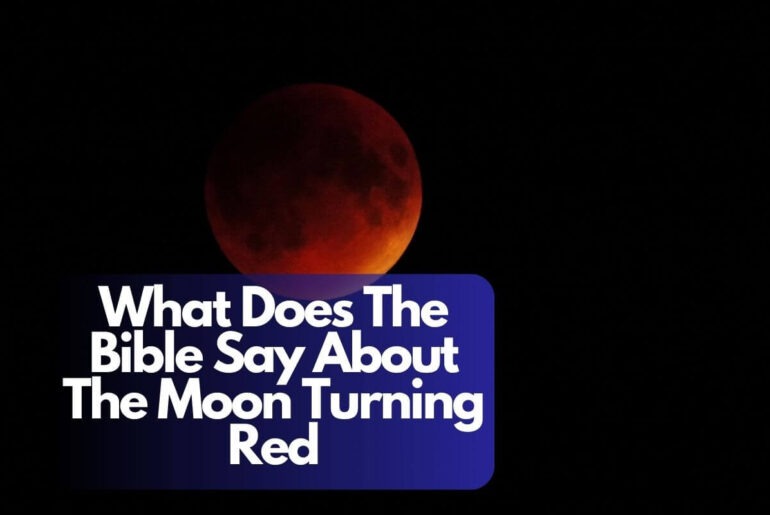The moon turning red has long captured the curiosity and wonder of humanity. From ancient times to modern-day, this celestial event has been associated with various interpretations and beliefs. But what does the Bible say about the moon turning red? In this article, we will delve into the scriptures to explore its significance, symbolism, and any potential prophetic implications. Join us as we seek to uncover the biblical teachings on the moon turning red and gain a deeper understanding of its spiritual meaning.
Contents
What Does The Bible Say About The Moon Turning Red
The Bible references the moon turning red in several passages, specifically in the context of end-times prophecies. One notable mention is found in the Book of Revelation, chapter 6, verse 12, which states:
Revelation 6:12
“I watched as he opened the sixth seal. There was a great earthquake. The sun turned black like sackcloth made of goat hair, the whole moon turned blood red…”
This verse is part of a series of events described in Revelation that are believed to occur during a time of tribulation. The mention of the moon turning red is often associated with a celestial sign or a symbolic representation of cosmic disturbances and impending judgment.
Additionally, in the Book of Joel, chapter 2, verse 31, it is written:
“The sun will be turned to darkness and the moon to blood before the coming of the great and dreadful day of the Lord.”
This passage, along with other verses in Joel, also describes cosmic signs as harbingers of divine judgment. The reference to the moon turning to blood signifies a profound and extraordinary event that precedes the arrival of God’s judgment upon the earth.
It’s important to note that these biblical references are apocalyptic in nature and should be interpreted within the context of eschatological beliefs. Different theological interpretations exist regarding the symbolism and literalness of these passages. Therefore, understanding the significance of the moon turning red in the Bible requires studying various interpretations and perspectives within the broader context of biblical prophecy.
Fascination with celestial phenomena and the moon turning red
The night sky has always captivated human beings, and celestial events like the moon turning red have sparked fascination and intrigue throughout history. The moon turning red, also known as a “blood moon,” refers to a phenomenon where the moon appears to have a reddish hue during a lunar eclipse or other atmospheric conditions. This captivating spectacle has caught the attention of people across cultures and has given rise to various interpretations and beliefs.
Purpose of exploring the biblical perspective on the moon turning red
In the search for understanding and meaning behind natural phenomena, many turn to the wisdom and guidance found in religious texts. The Bible, as a revered and authoritative book for Christians, contains teachings that address various aspects of life, including celestial events. Exploring the biblical perspective on the moon turning red provides an opportunity to delve into the spiritual and symbolic significance attributed to this phenomenon and gain insights from a religious standpoint.
Importance of seeking guidance from the Bible for understanding this phenomenon
Seeking guidance from the Bible is crucial when exploring the significance of the moon turning red because it provides a spiritual and theological framework for interpreting the natural world. The Bible offers narratives, prophecies, and teachings that can shed light on the symbolic meanings, spiritual implications, and theological insights associated with celestial phenomena. Understanding the biblical perspective on the moon turning red helps individuals gain a deeper appreciation for the wonders of creation and invites reflection on their own spiritual journey.
By examining the biblical perspective on the moon turning red, we can explore the profound connections between the natural world and the spiritual realm, unravel the symbolic meanings attributed to this celestial event, and gain a deeper understanding of the Creator’s intricate design.
Celestial Events in the Bible
Biblical accounts of extraordinary celestial events
Throughout the Bible, there are several accounts of extraordinary celestial events that have captured the attention of people in biblical times. These events often carry significant meaning and serve as divine signs, marking important moments in history or conveying spiritual messages. Examples include the star of Bethlehem that guided the Magi to Jesus’ birthplace and the darkening of the sun during Jesus’ crucifixion.
Instances of the moon turning red mentioned in the Bible
The Bible also mentions instances where the moon appears to turn red. One notable reference is found in the book of Joel in the Old Testament, where the prophet Joel speaks of the moon turning into blood as a sign preceding the day of the Lord. This prophetic language paints a vivid picture of cosmic and celestial events that accompany significant spiritual and eschatological events.
Understanding the significance of celestial occurrences in biblical times
In biblical times, celestial events held deep symbolic and spiritual significance. They were often seen as divine manifestations or interventions in the natural order of the world. These events were interpreted as signs from God, conveying messages, warnings, or the fulfillment of prophecies. The celestial occurrences, including the moon turning red, were believed to reflect the spiritual state of the world or mark significant transitions in God’s redemptive plan.
Exploring the celestial events mentioned in the Bible, including instances of the moon turning red, provides a rich tapestry of spiritual symbolism and divine communication. It deepens our understanding of how the natural and supernatural realms intertwine, and it invites us to contemplate the grandeur and mystery of God’s creation. By studying these celestial events, we can glean insights into the unfolding of God’s plan and reflect on the relevance of such phenomena in our own faith journey.
Symbolism and Prophetic Meanings
The color red holds symbolic significance in biblical and ancient Jewish literature. It often represents blood, sacrifice, judgment, and purification. When applied to the moon, the red color may convey a message of impending judgment, divine intervention, or a significant turning point in God’s plan. Ancient Jewish texts also associate a red moon with the idea of divine wrath or the arrival of the Messiah.
Possible prophetic implications of the moon turning red
The mention of the moon turning red in biblical prophecy has sparked discussions about its possible prophetic implications. Some interpret it as a sign of impending judgment or a significant event marking the end times. It may symbolize the purification of the earth or the coming of the Messianic age. However, it’s important to approach these interpretations with humility, recognizing that specific details about the moon turning red and its precise meaning are not explicitly spelled out in the Bible.
Understanding the symbolism of blood and its associations in biblical context
Blood holds deep symbolism in the Bible, representing life, sacrifice, and atonement. The imagery of the moon turning red as blood taps into this symbolism, possibly suggesting a time of judgment, purification, or a profound spiritual transformation. The association of blood with redemption and the forgiveness of sins underscores the profound spiritual implications tied to the moon turning red.
Exploring the symbolic and prophetic meanings associated with a red moon in biblical and ancient Jewish literature enhances our understanding of its potential significance in the context of God’s plan and the unfolding of eschatological events. While we must approach these interpretations with caution, recognizing the limitations of our understanding, they invite us to reflect on the spiritual truths conveyed through celestial phenomena and deepen our anticipation of God’s ultimate fulfillment of His redemptive purposes.
Natural Explanations for a Red Moon
The term “blood moon” is often used to describe the reddish appearance of the moon during a total lunar eclipse. During this event, the Earth comes between the sun and the moon, casting a shadow on the moon’s surface. The reddish hue is caused by the Earth’s atmosphere filtering out shorter wavelengths of light, such as blue and green, while allowing longer wavelengths, like red and orange, to pass through. This phenomenon is a result of the scattering of sunlight by the Earth’s atmosphere.
Atmospheric conditions and processes that cause the moon to appear red
The Earth’s atmosphere contains various particles, such as dust and pollutants, as well as molecules that scatter sunlight. During a lunar eclipse, sunlight passes through the Earth’s atmosphere and gets refracted or bent, similar to how light passes through a prism. The atmosphere scatters shorter wavelengths of light, resulting in the blue and green colors being dispersed, while longer wavelengths, such as red and orange, remain and give the moon its reddish appearance.
Differentiating between natural occurrences and supernatural signs
While a red moon during a lunar eclipse can be a visually stunning event, it is important to differentiate between natural occurrences and supernatural signs. The scientific explanation behind the phenomenon of a blood moon provides an understanding of the physical processes involved. It is essential to approach such events with discernment, acknowledging that natural phenomena can have awe-inspiring beauty and significance without necessarily carrying specific spiritual or prophetic meanings. As believers, we should be cautious not to attribute supernatural or prophetic significance to every natural occurrence, but rather seek guidance from Scripture and the leading of the Holy Spirit to discern the true signs and messages from God.
Interpreting Silence and Context
Recognizing the absence of explicit mentions of the moon turning red in the Bible
It is important to note that while the Bible contains various accounts of celestial events, there is no specific mention of the moon turning red as a standalone phenomenon. Understanding this silence helps us approach the topic with caution and avoid attributing specific meanings or interpretations to it without clear biblical support.
Considering the cultural and historical contexts of biblical times
To interpret the significance of a red moon, it is crucial to consider the cultural and historical contexts of biblical times. The ancient Israelites and surrounding cultures had their own beliefs and understandings of celestial events. Exploring their cosmology, symbolism, and cultural practices can provide valuable insights into how they may have interpreted such occurrences.
Applying biblical principles to the discussion of a red moon
Although there may not be direct references to a red moon, we can apply general biblical principles to the discussion. These principles include seeking wisdom and discernment, interpreting Scripture in its entirety, and prioritizing the central themes and teachings of the Bible. By grounding our interpretation in these principles, we can avoid the temptation to read into specific events or phenomena and instead focus on the broader messages and truths conveyed throughout the Scriptures.
Ultimately, while the Bible does not provide explicit guidance on the meaning of a red moon, we can approach it with humility, using biblical principles as a guide and seeking spiritual discernment. It is essential to avoid excessive speculation or assigning undue significance to natural phenomena, focusing instead on the central message of Scripture and our relationship with God.
Spiritual Discernment and Faith
Importance of discernment in interpreting celestial events
When encountering celestial events like the moon turning red, it is crucial to exercise discernment. Discernment involves seeking the guidance of the Holy Spirit, aligning our interpretations with biblical teachings, and filtering out potential misconceptions or false interpretations. This discernment helps us avoid being swayed by sensationalism or unfounded claims, ensuring that our understanding remains rooted in truth.
Trusting in God’s sovereignty and His revelation through the Bible
As we explore the significance of the moon turning red, it is essential to maintain trust in God’s sovereignty. God is the creator and sustainer of the universe, and He reveals Himself through the Scriptures. Therefore, our interpretation of celestial events should be guided by the truths and principles found in His Word. Trusting in God’s sovereignty enables us to approach these phenomena with a balanced perspective, acknowledging that His ways are higher than ours.
Balancing faith and scientific understanding in the exploration of the moon turning red
The exploration of celestial events like a red moon involves a delicate balance between faith and scientific understanding. While science provides valuable insights into the natural processes behind such occurrences, faith reminds us of the divine purpose and meaning that may transcend scientific explanations. It is essential to recognize that science and faith are not inherently contradictory but can complement each other in our pursuit of understanding. By maintaining this balance, we can appreciate both the wonders of God’s creation and the spiritual insights that celestial events may offer.
In conclusion, discernment, trust in God’s sovereignty, and a balanced approach to faith and scientific understanding are crucial when exploring the significance of the moon turning red. By seeking spiritual discernment, relying on God’s revelation in the Bible, and maintaining a balanced perspective, we can navigate this topic with wisdom and faith. Ultimately, our goal is to deepen our understanding of God’s creation and draw closer to Him, rather than getting caught up in speculation or sensationalism.
Conclusion
Throughout this exploration of the moon turning red, we have delved into various aspects, including celestial events in the Bible, symbolism and prophetic meanings, natural explanations, interpreting silence and context, and the importance of discernment. We have seen that while the Bible may not explicitly mention a red moon, it provides valuable insights for our understanding.
As we navigate the topic of the moon turning red, it is crucial to approach it with discernment and open-mindedness. We should be cautious of sensationalism and unfounded claims, instead relying on the guidance of the Holy Spirit and aligning our interpretations with biblical teachings. Discernment helps us discern between natural occurrences and potential supernatural signs, fostering a balanced perspective.
While our exploration of the moon turning red may raise questions and curiosity, it is important to remember that the Bible primarily offers spiritual lessons and principles. Celestial phenomena, including the moon turning red, can serve as reminders of God’s power, sovereignty, and the urgency of seeking Him. They can also inspire awe and wonder at His magnificent creation. By focusing on the spiritual insights and lessons the Bible provides, we can grow in our faith and deepen our relationship with God.
By seeking spiritual insights, we can find deeper meaning, grow in faith, and draw closer to God, ultimately experiencing the transformative power of His Word.








